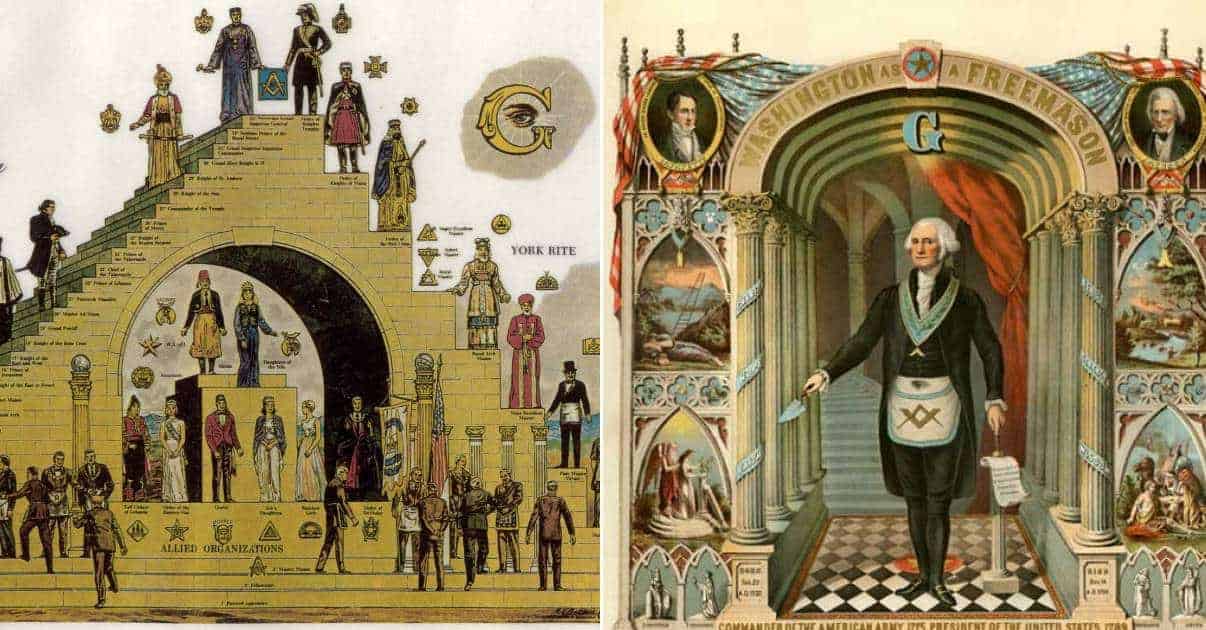The earliest known records of Freemasonry in North America date from the second decade of the eighteenth century in eastern Pennsylvania. Traveling to the North American colonies from England, Scotland, and Ireland Freemasonry brought the then radical ideas of religious tolerance and individual liberty, ideas which found fertile ground in which to germinate in the New World. As the colonies began to produce a new manner of being – an American – the ideas and beliefs of Freemasonry gradually took hold of its core. Many of the most prominent members of pre-revolutionary colonial society were Freemasons, and their influence is visible in American society today. Their influence has also been the source of conspiracy theories over the decades, some bordering on the bizarre. One such theory is that the Freemasons faked the moon landings, for example, another claims Freemasonry to be a Jewish front aimed at world domination.
It is a fact that several of the nation’s founders were Freemasons, including Benjamin Franklin and George Washington. It is also a fact that an equal if not greater number of the founders were not. Pierre L’Enfant, who designed much of the nation’s capital city, was a Freemason. So was Benjamin Latrobe, who designed the Capitol and other buildings. Thomas Jefferson, who influenced both, was not. At least 14 American presidents were Freemasons, as were numerous government officers and influential businessmen.

Here are ten American presidents who were Freemasons and their impact on the American experience.

George Washington
In the British colonies of North America men of influence and means, aping society of Great Britain, gathered in Masonic lodges in part to discuss in private relevant issues and business, interact with their fellows, and propose and plan improvements for their communities. George Washington, as a wealthy landowner and militia officer in Virginia, joined Fredericksburg Lodge #4 in 1752, where he could meet and entertain the opinions of other Virginians of influence, in politics, military affairs, and business.
That Washington placed great value on his membership is obvious. During the Revolutionary War he corresponded regularly with fellow members, of his own Lodge and others. He attended meetings of military lodges whenever the press of his duties would permit, often presiding over initiation of new members. Lafayette – another Mason – presented Washington with Masonic aprons on at least two occasions during the war, one of which had been painstakingly embroidered by Madame Lafayette. Lafayette asserted long after the war that Washington would “… never willingly give independent command to officers who were not Freemasons.”
After the war, while in his second term as President of the United States, Washington addressed the Grand Lodge of Massachusetts by letter, in which he wrote, “…the Masonic institution was one whose liberal principles are founded on the immutable laws of truth and justice and whose grand object is to promote the happiness of the human race.”
When Washington prepared to become the first man to take to oath of office specified in the Constitution, he asked to use a Bible belonging to St John’s Masonic Lodge # 1 of New York City. Washington was by then Master of Alexandria (Virginia) Lodge # 22, formed after the Revolution, and in close proximity to Washington’s home at Mount Vernon. He remained with this Lodge for the rest of his life. After his death it was renamed the Alexandria-Washington Lodge in his honor.
In the early 20th century the Lodge purchased a tract of land and had a memorial built to Washington, designed after the ancient Lighthouse at Alexandria in Egypt, one of the Seven Wonders of the Ancient World. It is both the home of the Alexandria-Washington Lodge and open to visitors or other groups who wish to use its meeting spaces. The Masonic apron embroidered by Madame Lafayette and given to Washington by the Marquis can be seen there.

